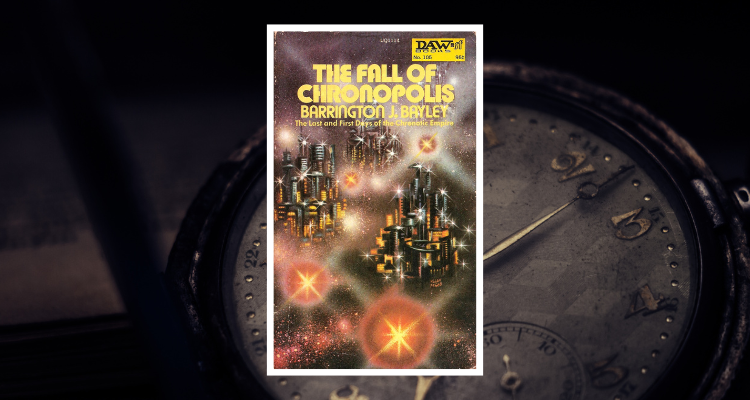|
Not a space opera but what we might call a “time opera”, Bayley’s fifth novel is a pulpy tale of imperial struggle in the shifting time streams.
Barrington J. Bayley (1937 - 2008) spent much of the 1970s writing space opera science fiction which blended the excitement of the pulp era with the experimentalism of the New Wave. Originally published in 1974, The Fall of Chronopolis is something different. It preserves the formidable ships, baroque plotting, and fundamental strangeness of something like The Garments of Caean (1976). But here, as the title implies, Bayley’s vessels travel not in space, but rather in time. In this setting, humans have not mastered spaceflight. Instead of dominating the stars they have sought to extend their control over time. The Chronotic Empire, ruled over by the Ixian dynasty, controls a swathe of hundreds of years of history. Its powerful Time Fleets are made up of time-travelling vessels which seek to head off any threats from other points in time. However in The Fall of Chronopolis, the Empire faces twin dangers both from within and from without, which threaten to bring the whole edifice crashing down.
The Fall of Chronopolis is essentially pure pulp. This is not particularly high-minded or ideas-driven science fiction, but a finely tuned entertainment which draws on Bayley’s substantial skills.
The book has a number of narrative threads. The most important focuses on Mond Aton, a senior officer in the Chronotic Empire’s Third Time Fleet. He commands a ship, the colourfully named Smasher of Enemies, which takes part in an operation against the Empire’s principal external rival, known as the Hegemony. This regime is situated further into the future than the Empire, and possesses time-ships of its own - not to mention a new weapon that can erase entire cities from the time-stream. During a pivotal battle, Aton encounters aboard his ship elements of the Empire’s internal foe - a malevolent cult which threatens to rot society from the inside. Soon, Aton finds himself being falsely accused of cowardice and treason. His punishment is to serve as a courier transmitting a message between the Empire’s fleets; this is a suicide mission, because each messenger is implanted with a phrase which triggers their sudden death. The other story strands focus variously on an Ixian aristocrat who is obsessed with the missing corpse of his deceased, beloved sister; a young woman hunted by the cult from world to world; and the progression of the war between the Empire and the Hegemony. Inevitably, Aton finds that far from being over, his role in the fate of the Empire - and perhaps of time itself - is just beginning.
In its early chapters, The Fall of Chronopolis can be a bit confusing. This is mainly because while the story ticks many of the boxes expected of space opera, it actually doesn’t really fit within that genre. The travels and battles of the Fleet do not take place in space, but rather in time - what Bayley calls the “temporal substratum” or “strat” for short. In this setting, time has peculiar properties. It is organised around a series of seven nodes. These are relatively stable, including the one in which the grand city of Chronopolis itself is based. Between the nodes, the chaos of the strat holds sway.
Years later, Bayley would become involved with Games Workshop and wrote a number of stories in the setting of Warhammer 40,000. These included a novel, Eye of Terror (1999). It is known that 40K takes influence from a number of prominent British SF and fantasy stories, not least those written by Bayley’s friend and collaborator Michael Moorcock. The strat in The Fall of Chronopolis could well have been an influence on the immaterium or the warp in 40K. Both are otherworldly means of travel with the potential to drive unprotected travellers insane. Similarly, in the novel there is a sort of revered, gothic machine called the Imperator which ostensibly contains the collective intelligence of previous rulers of the Chronotic Empire. Neither fully alive nor truly dead, this concept seems to anticipate another element of 40K lore - the Emperor of Mankind. The Emperor was also likely inspired by King-Emperor Huon, the principal villain in Moorcock’s Hawkmoon series that began with The Jewel in the Skull (1967).
The Fall of Chronopolis is not as strong a novel as The Garments of Caean but it does have a strong appeal of its own. Its bravura weirdness and the way in which Bayley gradually pulls together its various plot threads are both impressive. Writing in the Science Fiction Encyclopedia (SFE), John Clute described the book as Bayley’s most impressive use of the time travel theme. Rhys Hughes went as far as to call it “possibly the ultimate time-travel story”. While on its face this seems an extreme statement, it does reflect the massive scale of the implications in Bayley’s shattering climax.
Have you read The Fall of Chronopolis or other novels by Barrington J. Bayley? How does it rank for you alongside other time travel tales? Be sure to let me know in the comments below.
0 Comments
Your comment will be posted after it is approved.
Leave a Reply. |
About
Exploring classic science fiction, with a focus on the 1950s to the 1990s. Also contributing to Entertainium, where I regularly review new games. Categories
All
|

